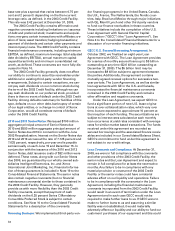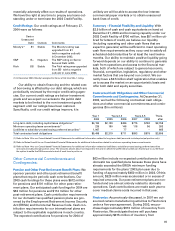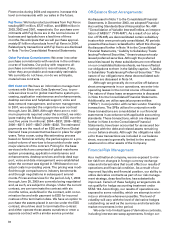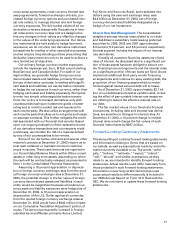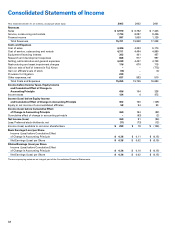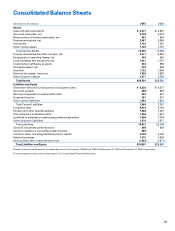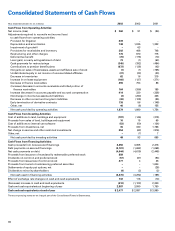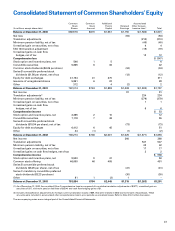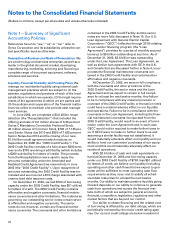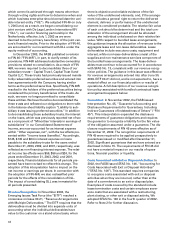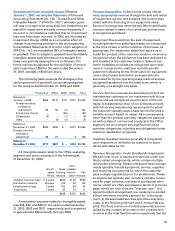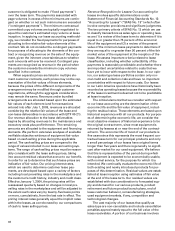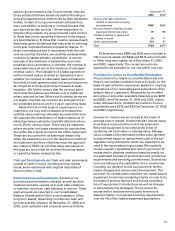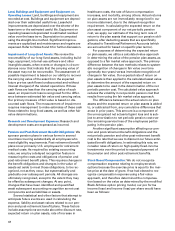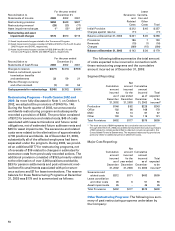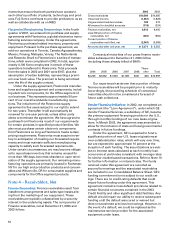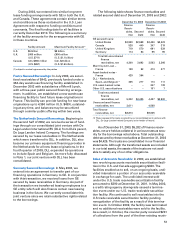Xerox 2003 Annual Report Download - page 45
Download and view the complete annual report
Please find page 45 of the 2003 Xerox annual report below. You can navigate through the pages in the report by either clicking on the pages listed below, or by using the keyword search tool below to find specific information within the annual report.
43
grade and we expect our access to the public debt
markets to be limited to the non-investment grade
segment until our ratings have been restored.
Specifically, until our credit ratings improve, it is
unlikely we will be able to access the low-interest
commercial paper markets or to obtain unsecured
bank lines of credit.
We currently have a $2.5 billion shelf registration
that enables us to access the market on an opportunis-
tic basis and offer both debt and equity securities.
Basis of Consolidation: The Consolidated Financial
Statements include the accounts of Xerox Corporation
and all of our controlled subsidiary companies. All sig-
nificant intercompany accounts and transactions have
been eliminated. Investments in business entities in
which we do not have control, but we have the ability
to exercise significant influence over operating and
financial policies (generally 20 to 50 percent owner-
ship), are accounted for using the equity method of
accounting. Upon the sale of stock of a subsidiary, we
recognize a gain or loss in our Consolidated
Statements of Income equal to our proportionate
share of the corresponding increase or decrease in
that subsidiary’s equity. Operating results of acquired
businesses are included in the Consolidated
Statements of Income from the date of acquisition
and, for variable interest entities in which we are
determined to be the primary beneficiary, from the
date such determination is made.
Certain reclassifications of prior year amounts
have been made to conform to the current year
presentation.
Income before Income Taxes, Equity Income and
Cumulative Effect of Change in Accounting Principle:
Throughout the Notes to the Consolidated Financial
Statements, we refer to the effects of certain changes
in estimates and other adjustments on Income before
Income Taxes, Equity Income and Cumulative Effect of
Change in Accounting Principle. For convenience and
ease of reference, that caption in our Consolidated
Statements of Income is hereafter referred to as
“pre-tax income.”
Use of Estimates: The preparation of our Consolidated
Financial Statements in accordance with accounting
principles generally accepted in the United States of
America requires that we make estimates and
assumptions that affect the reported amounts of
assets and liabilities, as well as the disclosure of con-
tingent assets and liabilities at the date of the financial
statements, and the reported amounts of revenues
and expenses during the reporting period. Significant
estimates and assumptions are used for, but not limit-
ed to: (i) allocation of revenues and fair values in leas-
es and other multiple element arrangements; (ii)
accounting for residual values; (iii) economic lives of
leased assets; (iv) allowance for doubtful accounts;
(v) inventory valuation; (vi) restructuring and related
charges; (vii) asset impairments; (viii) depreciable lives
of assets; (ix) useful lives of intangible assets; (x) pen-
sion and post-retirement benefit plans; (xi) income tax
valuation allowances and (xii) contingency and litiga-
tion reserves. Future events and their effects cannot
be predicted with certainty; accordingly, our account-
ing estimates require the exercise of judgment. The
accounting estimates used in the preparation of our
Consolidated Financial Statements will change as new
events occur, as more experience is acquired, as addi-
tional information is obtained and as our operating
environment changes. Actual results could differ from
those estimates.
The following table summarizes the more signifi-
cant charges that require management estimates:
Year ended December 31,
2003 2002 2001
Restructuring provisions
and asset impairments $176 $670 $715
Amortization and impairment of
goodwill and intangible assets 35 99 94
Provisions for receivables 224 353 506
Provisions for obsolete and
excess inventory 78 115 242
Depreciation and obsolescence of
equipment on operating leases 271 408 657
Depreciation of buildings
and equipment 299 341 402
Amortization of capitalized
software 143 249 179
Pension benefits –
net periodic benefit cost 364 168 99
Other post-retirement benefits –
net periodic benefit cost 108 120 130
Deferred tax asset valuation
allowance provisions (16) 15 247
Changes in Estimates: In the ordinary course of
accounting for items discussed above, we make
changes in estimates as appropriate, and as we
become aware of circumstances surrounding those
estimates. Such changes and refinements in estima-
tion methodologies are reflected in reported results of
operations in the period in which the changes are
made and, if material, their effects are disclosed in the
Notes to the Consolidated Financial Statements.
New Accounting Standards and
Accounting Changes:
Variable Interest Entities: In January 2003, the FASB
issued Interpretation No. 46, “Consolidation of
Variable Interest Entities, an interpretation of ARB 51”
(“FIN 46”). The primary objectives of FIN 46 were to
provide guidance on the identification of entities for



